It’s bad news if you believe in free will – at least when it comes to YouTube. That’s because 70% of what people watch on YouTube is based on YouTube’s algorithm for recommendations.
YouTube’s 2.5 billion users watch 694,000 minutes of video each minute, and the platform’s recommendation system accounts for the majority of those views.
As a result, marketers, influencers, and creators are obsessed with unlocking the YouTube algorithm’s secrets. The key to YouTube stardom is getting recommended to the right viewers at the right time, but what makes it tick? How can we use this mysterious formula to our advantage?
Well, ponder no more, my ‘Tube curious friends because in this blog post, we’ll cover everything about the Youtube algorithm that you’ve been dying to know.
- What the algorithm is (and isn’t)
- The most recent changes to the Youtube algorithm
- Pro tips for getting YouTube’s search and discovery systems to work for you
A brief history of the YouTube algorithm
What is the YouTube algorithm? To answer that question, let’s do a quick overview of how YouTube’s Algorithm has changed over the years. And how it works today.
2005 – 2011: Optimizing for clicks & views
According to founder Jawed Karim (a.k.a. the star of Me at the Zoo), YouTube was created in 2005 in order to crowdsource video of Janet Jackson and Justin Timberlake’s notorious Superbowl performance. So it makes sense that YouTube’s algorithm started off by recommending videos that attracted the most views or clicks.
Alas, this led to an increase in misleading titles and thumbnails (a.k.a. clickbait). User experience plummeted as videos left people feeling tricked, unsatisfied, or plain old annoyed.
2012: Optimizing for watch time
In 2012, YouTube adjusted its recommendation system to support time spent watching each video. It also included time spent on the platform overall. When people find videos valuable and interesting, they watch them for longer. Or so the theory goes.
This shift to reward watch time was a game changer. According to Mark Bergan, author of Like, Comment, Subscribe: Inside YouTube’s Chaotic Rise to World Domination,“[Watch time] had an immediate impact. Early YouTubers were basically making TikTok videos…but watch time created gaming, beauty vlogging, alt-right podcasts… all these verticals we now associate with YouTube.”
Accounts that were big performers previously (like videos from eHow, or MysteryGuitarMan) dropped off almost immediately.
YouTube’s algorithm change led some creators to try to make their videos shorter in order to make it more likely viewers would watch to completion. Others made their videos longer in order to increase watch time overall. YouTube didn’t comment on either of these tactics and maintained the party line: make videos your audience wants to watch, and the algorithm will reward you.
That said, as anyone who has ever spent any time on the internet knows, time spent is not necessarily equivalent to quality time spent. YouTube changed tack again.
2015-2016: Optimizing for satisfaction
In 2015, YouTube began measuring viewer satisfaction directly with user surveys. It also prioritized direct response metrics like Shares, Likes, and Dislikes (and, of course, the especially brutal “not interested” button).
In 2016, YouTube released a whitepaper describing some of the inner workings of its AI: Deep Neural Networks for YouTube Recommendations.
In short, the algorithm had gotten way more personal. The goal was to find the video each particular viewer wants to watch, not just the video that lots of other people have perhaps watched in the past.
As a result, in 2018, YouTube’s Chief product officer mentioned on a panel that 70% of watch time on YouTube is spent watching videos the algorithm recommends.
2016-present: Dangerous content, demonetization, and brand safety
Over the years, YouTube’s size and popularity have resulted in an increasing number of content moderation issues. And what the algorithm recommends has become a serious topic not just for creators and advertisers but for journalists and the government as well.
YouTube has said it is serious about its responsibility to support a diverse range of opinions while reducing the spread of harmful misinformation. Algorithm changes enacted in early 2019, for example, have reduced consumption of borderline content by 70%. (YouTube defines borderline content as content that doesn’t quite violate community guidelines but is harmful or misleading. Violative content, on the other hand, is immediately removed.)
This issue affects creators, who fear accidentally running afoul of ever-changing community guidelines. Or being punished with strikes, demonetization, or worse.
(Former CEO Susan Wojcicki said one of YouTube’s priorities in 2021 was increasing transparency for community guidelines for creators).
It also affects brands and advertisers, who don’t want their name and logo running alongside white supremacists.
Meanwhile, American politicians are increasingly concerned with the societal role of social media algorithms. YouTube (and other platforms) have been summoned to account for their algorithms at Senate hearings. And in early 2021 Democrats introduced a ”Protecting Americans from Dangerous Algorithms Act.”
Next, let’s talk about what we know about how this dangerous beast works.
How does the YouTube algorithm work in 2023?
The YouTube algorithm in 2023 delivers distinct recommendations to each user. These recommendations are tailored to users’ interests and watch history and weighted based on factors like the videos’ performance and quality.
When deciding what to recommend to each user, the YouTube algorithm takes into account the following:
- What videos have they enjoyed in the past? If you’ve watched a 40-minute video essay about the flags of the world or gave it a like or comment, it’s probably safe to say you found it interesting. Expect more flag content coming your way.
- What topics or channels have they watched previously? If you subscribe to the Food Network’s YouTube channel, the algorithm will likely show you more cooking content.
- What videos are typically watched together? If you watch “How to change a monster truck tire,” and most people who watch that also watch “Monster truck repair 101,” YouTube might recommend that as followup viewing.
That’s why a Millennial comedy-fan design-writer mom has a home page that looks like this:
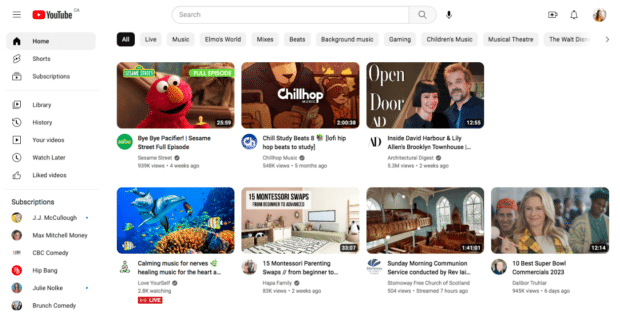
Of course, YouTube wants to recommend relevant, quality videos to each of its precious users. It’s not exactly a positive experience to follow a suggestion to watch “The World’s 36 Most Stylish Cats” and find it boring, low-quality or weirdly racist.
So how does YouTube evaluate if a video is worthy of recommendation?
First: it’s not about the content. The actual content of your video is not evaluated by the YouTube algorithm at all. Videos about how great YouTube is aren’t more likely to go viral than a video about how to knit a beret for your hamster.
“Our algorithm doesn’t pay attention to videos; it pays attention to viewers. So, rather than trying to make videos that’ll make an algorithm happy, focus on making videos that make your viewers happy,” says YouTube.
Instead, YouTube looks at the following metrics for its recommendation algorithm:
- Do people actually watch it? When a video is recommended, do people actually watch it, ignore it, or click “not interested”?
- How long do people watch it? The YouTube algorithm looks at both the view duration and the average percentage viewed to inform the ranking.
- Did viewers like it? Likes and dislikes are evaluated, as are engagement rates and post-watch survey results.
- What is your regional context? The time of day and the language you speak also influence the YouTube algorithm.
How YouTube determines the algorithm
More than 500 hours of content are uploaded to YouTube every single minute. The search system would be absolute chaos without the YouTube algorithm trying to help you find the most relevant content.
That’s right: the goal isn’t to bring you the most popular or the most recent video on your search term. It’s to bring you the video that you specifically will find the most useful.
That’s why two different users searching for the same term may see a totally different list of results.
YouTube’s search algorithm prioritizes the following elements:
- Relevance: The YouTube algorithm tries to match factors like title, tags, content, and description to your search query.
- Engagement: Signals include watch time and watch percentage, as well as likes, comments, and shares.
- Quality: To evaluate quality, the algorithm looks at signals to determine the channel’s authority and trustworthiness on a given topic.
- User search and watch history: What have you enjoyed or viewed in the past? This will impact which search results the YouTube algorithm will assume will be helpful.
That being said: these factors are combined in slightly different ways, depending on where on YouTube you are receiving recommendations.
YouTube recommends videos in three different places on the platform.
Home
This is what you see when you open up the YouTube app or visit the YouTube website. It’s personalized to each viewer. The recommendation engine selects videos for the Home screen based on…
- Performance of the video
- Watch and search history of the user
Suggested Videos
These are the videos recommended alongside the video you’re already watching: the list of vids that appear under ‘Up Next.” The algorithm suggests videos here based on…
- The topic of the current video
- The viewer’s watch history
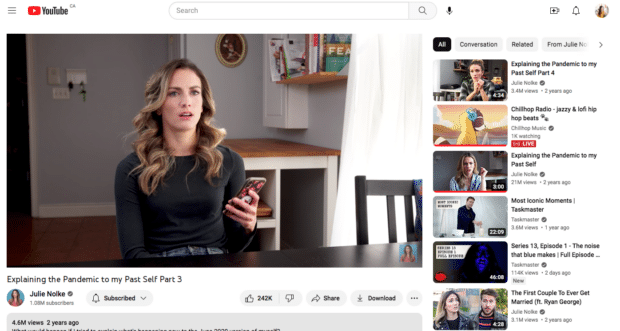
Search
The keyword obviously plays a role here. But each user’s search results will be slightly different thanks to the personalized signals the algorithm takes into account. These signals include:
- The relevance of the title, description, and video content to the search term
- Performance and engagement of video
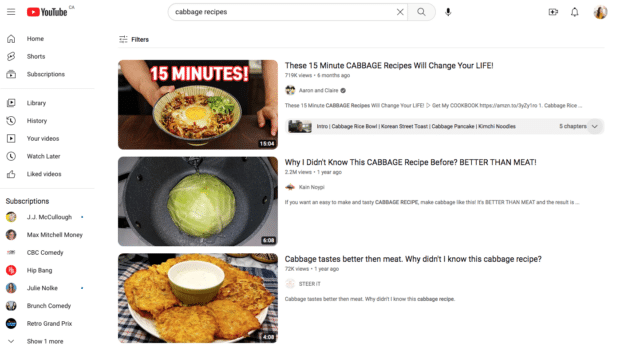
What is the YouTube shorts algorithm?
YouTube Shorts are short, vertical videos created using a smartphone and uploaded directly to YouTube from the YouTube app, like Stories. Millions of YouTube viewers are watching Shorts daily… so don’t sleep on this new format.
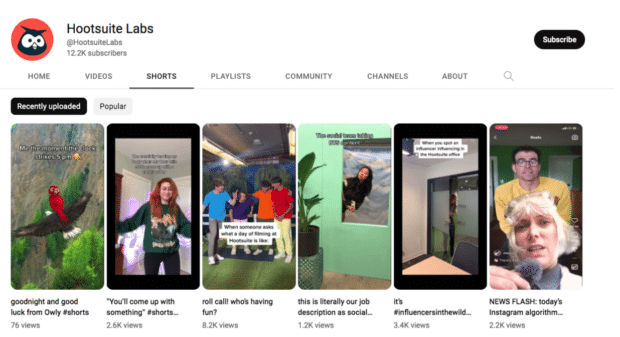
YouTube’s VP of Product Management described Shorts as “a new short-form video experience for creators and artists who want to shoot short, catchy videos using nothing but their mobile phones,” and goes on to say, “Shorts is a new way to express yourself in 15 seconds or less”.
But how do you get your Shorts discovered?
YouTube users can find and watch Shorts on the YouTube homepage or via the Shorts tab on the website or app. Shorts are subject to the same recommendation signals as “long” YouTube videos. (YouTube Classic?)
Here’s what the YouTube Shorts algorithm takes into account:
- Relevance: Do the title, tags, content, and description match the search term?
- Engagement: Do other people like and comment on this video?
- User watch history: What have you enjoyed or viewed in the past?
- Similar content: What other Shorts do similar audiences like to watch?
- Watch time: Less important than for classic videos. But if someone can’t even sit through a 15-second video, that’s probably not a good sign.
Hot tip: you can schedule your YouTube, uh, Longs via the Hootsuite Dashboard so you have time to focus on more spontaneous YouTube Shorts on the go.
Paige Cooper is the Hootsuite Inbound YouTube Lead. She runs Hootsuite Labs, our Youtube channel and she sees Shorts as an opportunity ripe for the taking.
“The rise of vertical video hasn’t changed the main algorithm per se, but YouTube Shorts are creating a big new opportunity for creators,” she says. “If you’re already running an Instagram Reels or TikTok strategy, publishing on YouTube Shorts seems to be an easy win.”
11 tips to improve your organic reach on YouTube
All that said, when it comes to working with the YouTube algorithm, remember that the algorithm follows the audience. If you already have a YouTube marketing plan in place, these tips will help you grow your channel’s views.
Do your keyword research
There’s no human being sitting at YouTube headquarters watching your video and ranking it.
Instead, the algorithm looks at your metadata as it decides what the video is about, which videos or categories it’s related to, and who might want to watch it.
When it comes to describing your video for the algorithm, you want to use accurate, concise language that people are already using when they search.
For example, if you were uploading a comedy sketch, you should probably include the words “comedy” and “funny” in the title and description and be crystal clear about the topics or subject of the vid.
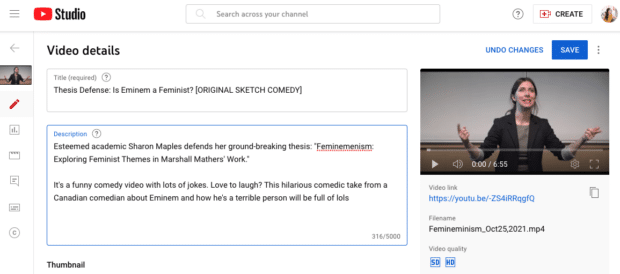
Because YouTube is a search engine as much as a video platform, you can conduct your keyword research in the same way you would for a blog post or web copy: using free tools like Google Adwords or SEMrush.
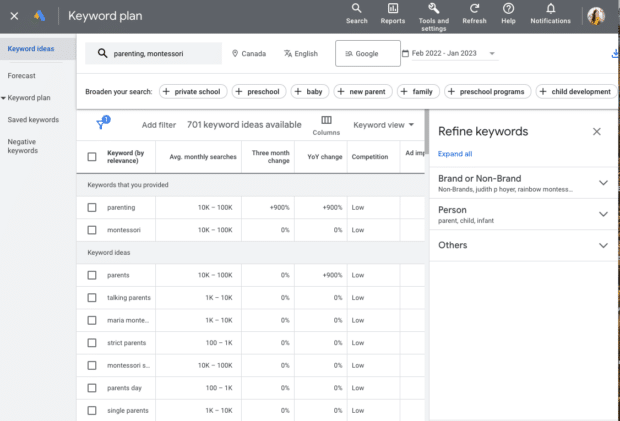
Once you’ve identified your primary keywords, you’ll want to use them in four places:
- In the video’s file name (i.e., laparoscopic-appendectomy.mov)
- In the video’s title (using catchy natural language like “Real life step by step laparoscopic appendectomy”)
- In the YouTube video description (especially within the first two lines, above the fold)
- In the video’s script (and therefore in the video’s subtitles and closed captions—which means uploading an SRT file).
But there’s one place you don’t need to put your keywords:
- In the video’s tags. According to Youtube, tags “play a minimal role in video discovery” and are most helpful if your keyword or channel name is often misspelled. (i.e., laporoscopic, lapparascopic, appendictomy, apendectomy, etc.) Adding excessive tags to your video description could even harm your video. It’s against YouTube’s policies on spam, deceptive practices, and scams.
Make it impossible for people to resist clicking on your thumbnail
But without being clickbaity, obviously.
“Appeal” is the word YouTube uses to describe how a video entices a person to take a risk (albeit a minor one) and watch something new. While YouTube itself doesn’t care what your thumbnail looks like visually, it is keeping track of whether or not people actually click through.
YouTuber J.J. McCullough uses a consistent style for his thumbnails that usually feature his face, a succinct title, and intriguing imagery.
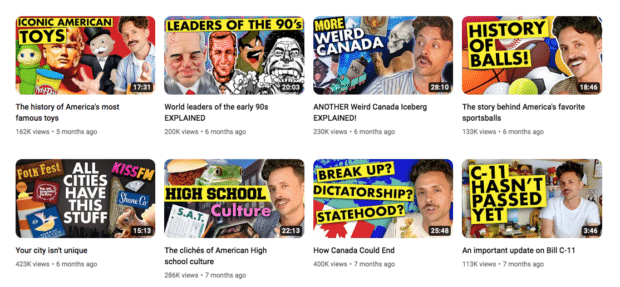
To maximize your video’s appeal:
- Upload a custom thumbnail (and keep the visual style consistent across all your thumbnails)
- Write an intriguing, catchy title—the kind you can’t not click on
- Remember the first sentence or so of the description will show up in search, so make it interesting and relevant.
Keep people watching your video, and all your videos
Once you have a viewer watching one video, make it easy for them to keep watching your content and stay within your channel’s ecosystem.
For instance, the end of Taskmaster episodes feature a card that links to more videos and a prompt to subscribe to the channel.
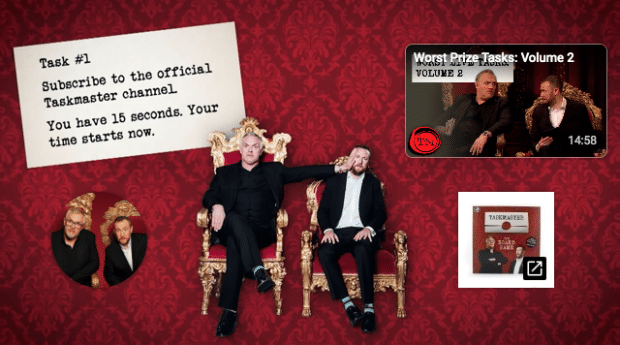
To this end, use:
- Cards: flag relevant other videos in your video
- End screens: end with a CTA to watch another relevant video
- Playlists: of topically similar videos
- Subscription watermarks (for more on converting viewers to subscribers, read our guide to getting more YouTube subscribers)
Pro Tip: Making a video series is a great way to capitalize on a recent spike in viewers. Using a scheduling tool like Hootsuite can make it easy to pre-plan your monthly factory tour or interview sessions in advance.
reference : https://blog.hootsuite.com




